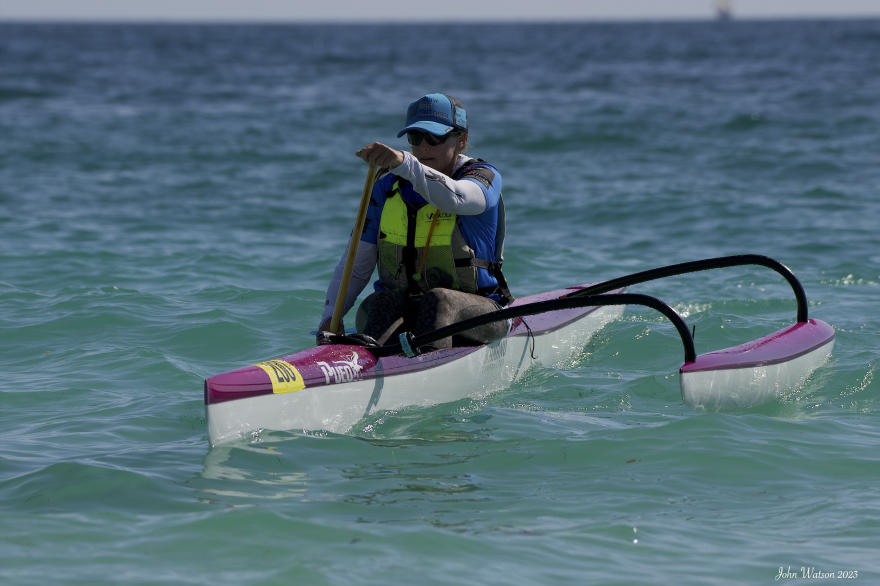Have you ever participated in an event where conditions didn’t align with your expectations? My recent adventure at the Shaw and Partners WA Race Week in Australia was just that – a series of unexpected conditions, from side winds to extreme heat, that pushed my adaptability to its limits.
I went into it thinking I would have amazing downwind conditions and blissfully surf my way through the four races. My heart sank as the forecast for the week unfolded. Instead of downwind for four races, we would face a side wind, no wind, upwind, light wind, and a peak race temperature of 42°C to top it off!
Without the wind, it took longer to finish each race, and there was no opportunity to rest while surfing. The amount of training I had done going into the week, the conditions, the racing frequency, and the coaching meant I was in for a tough week.
The Recovery Challenge
After the first race finished, the anticipation of having to race again so soon made me anxious. I realized I would need all the help I could get to recover enough to enjoy racing again without hurting myself.
The Thin Line Between Recovery and Burnout
Getting recovery right is about believing in the way my body feels and monitoring my state of mind. I love racing, so when I feel dread, I have learned that my body is sending me messages that I’m asking too much of it, and I need to pay attention.
If I’m feeling stressed or anxious about what I have planned, or if the tightness or soreness from the previous activity doesn’t fade, then I know I am not rested or recovered yet.
Recognizing these early warning signs was the first step in tuning into my body’s signals.
Listening to My Body’s Signals:
Here are some of the ways I feel when I’m not recovered:
Lack of desire to go again.
Feeling anxious and irritable.
Anticipating the race with an edge of negativity instead of excitement.
The event itself feels harder than it should.
My body won’t respond to working hard.
My performance is less than expected.
When I have ignored those messages in the past, I end up sick, injured, or frustrated.
Over time, I have learned to judge when I need to back off, take more time for recovery, or focus on specific recovery tools in order not to go backward.
As I watched the forecast unfold during the week in Australia, I assessed how I was feeling and turned my attention to my recovery to see what I could do to make it through the week.
Aware of these signals, I turned to my trusted recovery toolkit to navigate through.
My Recovery Toolkit
Immediately after racing:
• Arnica tablets straight after racing to reduce swelling.
• Amino acid drink to promote muscle repair.
• Eating protein and carbs to repair muscle and replace glycogen.
Later on:
• Epsom salt bath to reduce soreness.
• Arnica cream topically after the bath.
Next day:
• Active recovery in the form of coaching OC1 and swimming.
• Massage – found a local therapist and booked in the day after two of the races.
Daily:
• Creatine every morning.
• Amino acids between meals to keep the level high.
• Magnesium morning and evening.
• Generally eating enough food (read about the ups and downs of that here).
• Active release of tight areas with my massage ball.
The Turnaround – From Doubt to Ready
I approached the remaining races with awareness and belief in my system using these tools.
After the third race on Thursday evening, I wasn’t sure there was enough time for my body to recover before the final 27k race on Saturday afternoon. Still, I proceeded with my recovery plan and waited.
Amazingly, by Saturday mid-morning, after eating my second meal, I felt my body come alive, and I got excited about racing. I didn’t worry about whether or not I was ready. I knew I was. I didn’t have joint pain or feel any old injuries flare up. And, when I asked my body to push while racing, it responded. I raced strong and was pleased with how my body performed all the way to the end.
This journey from doubt to readiness reminded me of the power of effective recovery.
The Power of Effective Recovery
This was a massive week for me and required using every tool I could to make it through. My body adapted to the stress I endured, and I had fun racing. I know my recovery worked because instead of feeling broken at the end of the trip, I was able to return home to Hawaii and resume training a few days later.
I didn’t learn these strategies overnight; I learned them by listening to my body and knowing what it feels like NOT to be recovered, so I can tell the difference between that and feeling good.
It is worth it to focus on developing your own recovery method to help you adapt to your training and racing. It can be the difference between being able to join in or not and enjoying what you are doing!

